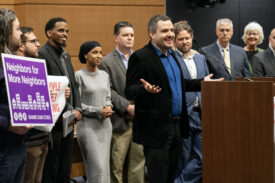 Editor’s note: The following essay is by blog contributor (and former Vancouver city councillor) Gordon Price, a reprint from his "Price Tags" newsletter and Business in Vancouver. (See the Price Tags version for accompanying images.)
Editor’s note: The following essay is by blog contributor (and former Vancouver city councillor) Gordon Price, a reprint from his "Price Tags" newsletter and Business in Vancouver. (See the Price Tags version for accompanying images.)
Why is the Provincial Government going to spend $3 to $5 billion on a strategy which it acknowledges will not work? If, as everyone seems to say, we can’t build our way out of traffic congestion, why are we desperately trying to do so?
Gordon Campbell chose Earth Day to pledge a new Pitt River Bridge and interchange at the Mary Hill Bypass. Said the press release: "(The bridge) will reduce congestion and pollution caused by idling vehicles, helping to improve air quality in the Fraser Valley airshed."
Improved air equality (leaving aside greenhouse gases) can only be achieved if the traffic keeps moving. Once it begins to congest again, air quality gets worse. So in fact the premise for the improvement must be that, yes, we can build our way of our congestion.
Even though we say we can’t.
"I’m one of those people who actually believes that you cannot build your way out of congestion," Transportation Minister Kevin Falcon told the Vancouver Board of Trade in a speech just last month. Gordon Campbell said as recently as March: "I know this: you can’t ever build yourself out of a transportation problem."
And yet governments, both regional and provincial, have announced the greatest commitment to road-building in the Lower Mainland in recent history. Add it up: the Golden Ears crossing, a twinning of the Port Mann Bridge, a widened Highway 1, new perimeter roads, upgraded interchanges – and more to come as the Gateway Program is implemented.
A huge loop consisting of the new bridges and widened roads will be constructed to join up both sides of the Fraser. It will greatly facilitate movement for short trips around the ring, particularly to serve the development that will cluster around the interchanges. (Check out the new 200th Street interchange where it’s already happening.) Logically, new development along the arterials will be complementary – in other words, big boxes, industrial parks, single-use residential developments, strip malls and shopping centres, all organized around abundant free parking. The growth both served and generated by the new roads and bridges will be designed almost exclusively on the assumption that everyone will drive almost everywhere for everything.
The result will turn the routes meant to handle through traffic, particularly the Trans-Canada Highway, into the main streets of suburbia. It will commit the fastest growing part of the GVRD to the automobile and truck, and to a future dependent on the price of oil.
Ironically, just as Vancouver is getting international credit for creating a livable, compact urban form, just as it is winning awards for its sustainability planning, just as it is about to host the World Urban Forum, we are committing huge resources to expand an oil-intensive transportation system that will only encourage the kind of sprawling growth that will clog up the transportation infrastructure we are building to handle the growth generated by the previous investments.
If this expansion is to make any sense at all, the government is obliged to demonstrate how a widened road or new bridge will be prevented from filling up to the point of congestion, which it will most certainly do if the road is seen as a free good. The government may have a model in mind which works, even if for political reasons they haven’t articulated what it is, since it probably involves tolls.
In what may have been a moment of excess enthusiasm, Kevin Falcon said last week on CBC that if tolls make sense on a widened Highway 1, the government will consider them. In fact, the project doesn’t make sense unless there are tolls – or some constraint on excess use.
Would the government take the risk? Given the Premier’s history as chair of the regional district and his willingness to entertain new policy initiatives (not to mention the Liberal’s platform "to lead the world in sustainable environmental management, with the best air quality … bar none") maybe he would. He’s certainly saying the right words: "You have to design your way out (of a transportation problem). You’ve got to design a community around trying to make sure (people) don’t have to move as much."
That is the basis of the regional plan that Campbell was instrumental in creating when he chaired the GVRD. It’s part of a vision that has served us since the 1970s and is now in danger of being dismantled by leadership south of the Fraser which does not wish to be constrained by mushy notions of sustainability.
But it is also the plan – and ultimately the future of the livable region – that is in danger of being buried under layers of new asphalt.
– Gordon Price








